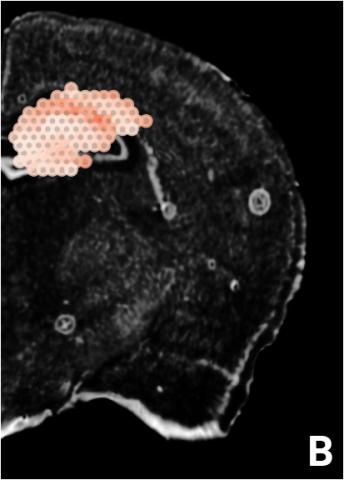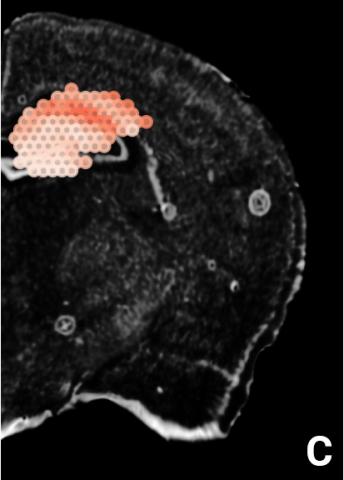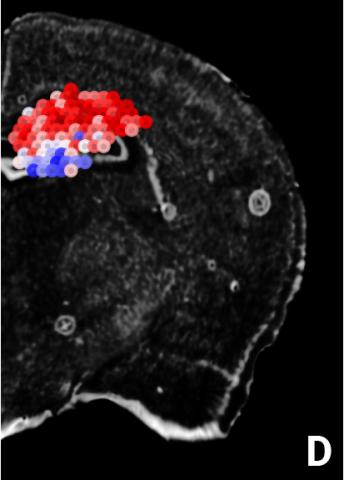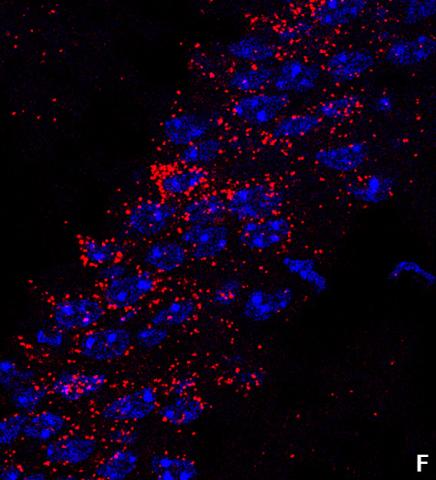Table of ContentsClose

Dream team: UI researchers uncover a new understanding of sleep
Iowa Neuroscience Institute researchers find that sleep deprivation affects each part of the brain differently, allowing for distinct computations influencing behavior, emotion, and memory.
Sleep. It’s cherished. It’s avoided. It’s sought after and protected—and yet often sacrificed. Above all else, it’s completely necessary. A lack of sleep has been shown to harm mental health, immune systems, cognitive abilities, and metabolisms, and it even reduces a person’s lifespan.
While researchers have learned much about sleep over the years, many uncertainties remain around its biological function. Findings published in late 2023 in Nature Communications by a University of Iowa Carver College of Medicine team of researchers—led by Ted Abel, PhD, director of the Iowa Neuroscience Institute and chair and department executive officer of the UI Department of Neuroscience and Pharmacology—sheds new light on the impact of sleep deprivation across the brain.
Prior to Abel’s research, a full understanding of sleep loss in the brain’s different regions didn’t exist. Over the decades, sleep researchers have observed neurological activities occurring in single areas of the under-slept brain and assumed these same activities also occurred in other areas of the brain. (See “Common sleep theories” for more on the previous leading sleep hypotheses.)
But the work by Abel’s team shows that sleep deprivation affects each part of the brain differently, indicating that sleep is a “local” phenomenon, allowing for distinct brain computations that affect motor behavior, emotion, and memory.
“Our finding is that wakefulness, and therefore sleep, has a different impact on the molecular signatures of different brain regions,” Abel says.
Abel’s research dispels two of the leading hypotheses about the function of sleep. These insights may lead to a better understanding of why and how we sleep—and unlock a way to boost wakefulness, too. One day, Abel says, these insights could even make people resilient to poor sleep.

Ted Abel, PhD
“These findings give us molecular targets to counteract the effects of sleep loss. Understanding the molecular changes that extended wakefulness has on the cortex is a way to think about helping us stay attentive, even with sleep loss.”
Why we sleep
The National Institutes of Health reports that roughly 50 million to 70 million people in the country have chronic or ongoing sleep disorders and that around 40% of people fall asleep without meaning to at least once a month. The effects can be deadly. For instance, more than 300,000 car crashes happen every year in the United States due to sleep deprivation. Worse yet, fatigue has contributed to major human-caused disasters, including everything from the nuclear reactor meltdowns at Chernobyl and Three Mile Island to the Challenger explosion and the Exxon Valdez oil spill.
While there’s no disagreement on the need for sleep, researchers have long had differing views on its function, Abel says. Various camps argue that sleep does everything from helping the brain grow, evolve, and repair itself to assisting our bodies in expending less energy.
One theory that most interests Abel and his team, though, is the sleep replay hypothesis, which states that sleep performs the work of memory consolidation, “replaying our memories and helping us to position them in space,” Abel says. In other words, sleep helps us reorganize our thoughts, building neural connections that could help us in the future—like a lab rat being able to better navigate a maze.
A second theory of particular interest to Abel—the synaptic homeostasis hypothesis—says “that sleep enables our brain to recover from the work of being awake,” he explains. The idea is that sleep gives our brains a rest after a long day of seeing, thinking, and making connections. Without that rest, the cognitive tasks we perform when conscious would eventually burn our brains out.
Abel’s research indicates that these two theories might be happening simultaneously. For instance, on a given night, the sleep replay hypothesis theory could play out in the cortex while the hippocampus operates under the synaptic homeostasis theory.
This means the brain isn’t like an assembly line that produces a single outcome again and again across its many regions—it’s more like a complex factory in which each area fabricates one part, with all of them coming together to create a unified whole. Different regions of the brain have different jobs during sleep, and when sleep doesn’t occur, those jobs go undone.

Developing a new sleep theory
For their research, Abel and his team relied on gene expression patterns—the process by which a gene is prompted to release the information encoded within it to impact certain bodily processes, such as the body triggering an immune response or metabolizing food.
To track these patterns, Abel and his colleagues used a technique called spatial transcriptomics, a method that allows scientists to see and map all the gene activity in a piece of tissue. In Abel’s study, the team added a slice of mouse brain on a slide and marked each slide with dots to create a kind of map.
“Those dots have a molecular marker, and there are about a thousand dots that half of a mouse brain would sit on, and each of those thousand dots is a different marker,” Abel says. “You can identify where different genes are expressed along the brain. In each dot, you’re recording the expression of 3,000 to 5,000 genes.”
In the photos below...
Sleep deprivation leads to an increase in expression of a number of genes in the hippocampus, including a gene called Arc. Below is a set of five images that depict the following. When a non-sleep-deprived brain (B) is compared to a sleep-deprived brain (C) and analyzed statistically (D), this increase in Arc levels can be demonstrated visually, shown here in red. Levels of Arc can be studied at the cellular level, using a technique called RNAScope. These levels, represented by red dots, are low when animals are sleeping (E) and increase when animals are kept awake (F).





What they learned is that each brain region has its own specific molecular fingerprint of the effects of wakefulness and sleep, Abel says.
As he explains, previous studies that formed the basis of the sleep replay hypothesis were conducted on the hippocampus, while most of the studies that resulted in the synaptic homeostasis hypothesis were performed on the cortex. As a result, decades’ worth of separate research teams had been looking at one area of the brain and incorrectly deducing that it represented the whole.
The future of sleep research
Abel and his colleagues are hopeful that the effects of sleep deprivation could someday be mitigated on a cellular level.
“These findings give us molecular targets to counteract the effects of sleep loss,” he says. “Understanding the molecular changes that extended wakefulness has on the cortex is a way to think about helping us stay attentive, even with sleep loss. In the hippocampus, we’ve identified molecular pathways that we can reverse, so animals can remember despite being sleep-deprived. We can basically make them resilient to sleep loss.”
Re-engineering sleep deprivation on this level is currently only available for lab animals and has no human applications yet, but Abel hopes his findings will someday turn these dreams into reality.
Sleep research glossary
Cortex: The outermost layer of the brain, responsible for most of the tasks of human attention, thought, perception, memory, and language.
Hippocampus: A region deep within the brain that plays an important role in consolidating memories (i.e., converting short-term memories into long-term memories or solidifying spatial memories, which are responsible for recording and recalling information related to a location or occurrence—like remembering when and where you left your car keys.)
Neuron: A cell that transmits an electrical signal between the brain and another part of the central nervous system.
Spatial transcriptomics: A scientific method that allows researchers to observe gene activity within a tissue sample and glean where different cell types are performing various functions.
Synapse: The end of a neuron, or the point at which two neurons connect and pass information (electrical signals) back and forth.

Common sleep theories
Sleep replay hypothesis: Sleep performs the work of memory consolidation.
Synaptic homeostasis hypothesis: Sleep enables our brain to recover from the work of being awake.
Evolutionary theory: We sleep for long periods of time because we are near the top of the food chain; it’s safe for us to sleep this way because we aren’t being hunted. (Small animals that are prey tend to sleep only for short periods.)
The “clean-up” theory: Our brain uses sleep as a chance to clear out cellular waste produced during waking hours.
Brain plasticity theory: Sleep gives the brain time and energy to grow and change.
